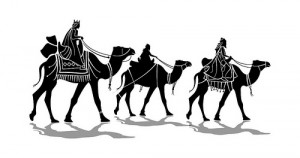My Memories Of El Día De Los Tres Reyes Magos
 When I was a little girl, the arrival of the Tres Reyes Magos meant something very special to me — a second chance at getting more gifts after Christmas. The Biblical meaning for me was a short story about a horrible king who wanted baby Jesus dead, and about three wise men walking across the desert to find the new king, baby Jesus, in a manger to offer him gifts. But, I also remember celebrating Christmas in my mother and father’s hometown of Zacatecas, in Mexico and in Juárez, México where one of my aunts lived.
When I was a little girl, the arrival of the Tres Reyes Magos meant something very special to me — a second chance at getting more gifts after Christmas. The Biblical meaning for me was a short story about a horrible king who wanted baby Jesus dead, and about three wise men walking across the desert to find the new king, baby Jesus, in a manger to offer him gifts. But, I also remember celebrating Christmas in my mother and father’s hometown of Zacatecas, in Mexico and in Juárez, México where one of my aunts lived.
All would put out these wonderful miniature replicas of the town of Bethlehem in their homes. The nativity scene would be placed at the edge of this tiny town. I also remember the Posadas, our Mexican version of caroling. It’s a reenactment of Joseph and Mary going from inn-to-inn, looking for lodging in Bethlehem before Jesus was born. We were a procession of aunts, grandparents, cousins and friends going from door-to-door in our neighborhood singing the pleas of Joseph and Mary for lodging.
With children in the group, the procession was never smooth sailing. There would be taunting and pushing and someone singing completely out of tune. There would be wounds from painful, hot wax on hands and the occasional odor of burnt hair due to someone getting too close to a lit candle or sparkler. At the end of our procession the participants were let into the final house and rewarded with brown paper bags full of peanuts, oranges and candy. We’d drink spiced tea and eat buñuelos. On Christmas Day, someone would pass the baby Jesus figurine around and have everyone in the room kiss him before he was placed in his bed in the manger. This ritual signified the birth of Jesus.
In Mexico, January 6, El Día de los Tres Reyes Magos, was truly the day to give and receive gifts. It is the day Melchor, Gaspar y Balthazar, the three wise men, arrived at the manger to meet Jesus and offered him their gifts. Instead of writing a letter to Santa Claus, I remember writing a letter to one of the three wise men asking for the toys I wanted and waking up to find a gift. On this day, we would all come together again to eat tamales, drink chocolate caliente, and find a little figure of baby Jesus in a Rosca De Reyes, our version of a bunt cake. The hiding of the plastic baby Jesus in the Rosca symbolized the effort to hide him from El Rey Herodas. The knife used to cut the cake signified the great danger baby Jesus was in.
As a child I may not have had all the facts regarding the true meaning of Christmas, but, what I do remember is that when I celebrated Christmas in Mexico, it was not about going shopping, and receiving a multitude of gifts. It was not about Santa Clause or elves on a shelf. I can’t even remember putting too much emphasis on trimming a Christmas tree, although we did have one. My memories of those times are of laughter, aromas of delicious food, and of generations of one family coming together and gathering around a miniature nativity scene to take part in the reenactment of an event that would change the world.
[Photo By vectorportal]
